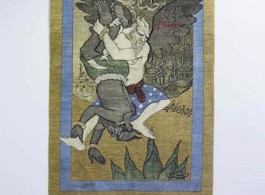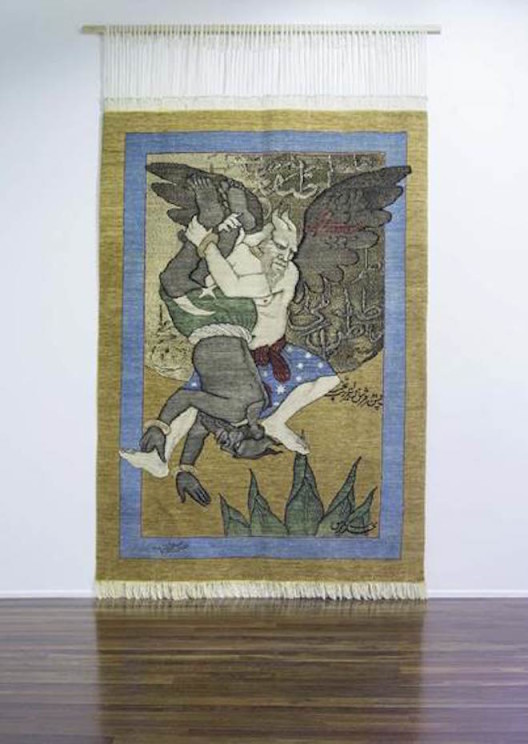June 28 – September 06, 2015
Opening Reception: Saturday, 27 June 2015, 4 – 7 pm
ARNDT Singapore is pleased to present a solo exhibition of new works by Sydney-based artist Khadim Ali. Following the style of miniature painting and rug making, Khadim makes use of traditional methods in his work which draws inspiration from Afghan mythology dating back thousands of years.
The artist hails from the Hazara minority in Afghanistan where his family was forced to flee from their home, escaping Taliban massacres. They settled in Quetta, Balochistan in Pakistan where Khadim was born and raised. In 2000, Khadim was accepted into the National College of Art in Lahore, Pakistan, where he specialised Miniature Painting. The turbulent times were unrelenting, and after losing many family members to the Taliban, Khadim realised it was no longer possible to continue his art making in Pakistan. He was offered a distinguished talent visa by the Australian government in 2010, and moved to Sydney. The relocation offered him greater mobility, and the opportunity to develop work incorporating other art forms.
Khadim Ali’s current body of work reflects his many concerns and demonstrates an adept way of combining mediums and conceptualizations. The artist ́s deepening anxieties about events in the region he still calls ‘home’, (both Pakistan and Afghanistan) reflects his responsibility concerning his role as an artist– and despite the harrowing conflicts that are implied throughout most of his practice, an unexpected sense of heroism prevails.
Venue
ARNDT Singapore Gillman Barracks
9 Lock Road #03-21
Singapore 108937
Opening hours: Tue-Sat 11am – 7pm, Sun 11am – 6pm. Closed on Mondays and Public Holidays.
About the Artist
Khadim Ali (b. 1978, Pakistan) has participated in numerous solo and group exhibitions since graduating from the
National College of Arts in Lahore, Pakistan in 2003, such as Contemporary Miniature Paintings from Pakistan, at
Fukuoka Art Museum, Japan (2004), The force of forgetting, Lismore regional Gallery, NSW, Australia (2011),
and No Country: Contemporary Art for South and Southeast Asia, Solomon R. Guggenheim Museum, New York City,
USA (2013). He holds an MFA from the College Of Fine Arts UNSW, Sydney, Australia where he lives and works.
About the Gallery
Established in 1994 as one of the first contemporary art galleries with an international profile in former East Berlin,
ARNDT expanded its operations to the vibrant art landscapes of Asia – particularly Southeast Asia and the Pacific
region. In its premises in Singapore, ARNDT presents its international and Asian program with solo exhibitions and
curated shows of established and emerging artists.
Fierce Narratives — New Works by Khadim Ali
The protagonists in the works of Khadim Ali originate from the many turbulent journeys he has negotiated. Perpetual migrations accompanied by loss and trauma, contribute to the potency of his images.
The artist belongs to the Hazara tribe from Afghanistan. His family was forced to flee from their home in Bamiyan during the Civil War following the Soviet invasion, when the Taliban took over Afghanistan. The travails of the Hazaras in Afghanistan are not new, they go back to the 19th century, when the tribe was conquered, massacred and enslaved by King Abdur Rehman. Still discriminated against today, they live as outcasts under continual threat.
Khadim Ali’s family escaped the Taliban massacres, settling in Quetta, Balochistan in Pakistan where he was born. Ali recalls his grandmother saying “That year the poppy fields in Bamiyan were a deeper red because of the blood that seeped into the soil.”
Khadim Ali’s grandfather was a teacher and a storyteller. Singing and reciting from the classic 10th century epics like the Shahnama, he would regale his community at sundown and Ali would sit entranced by stories of bravery, betrayals, daring and deception. Tales of warriors, demons, princes and angels; there was much for a child to absorb, to help forget his bleak surroundings.
When the Taliban entered Quetta, after being pushed out from Afghanistan post 9/11, the Hazaras were in peril yet again. The family splintered and Khadim Ali found temporary refuge, slipping across the border into Iran. He worked in turn, as a labourer, a cobbler and a farm worker. It was a happy chance that led him to show his drawings to the Master painter Ustad Shefai, who took him under his wing. He assisted his teacher in painting murals, mostly of Khomeni and slain martyrs which was about all that was tolerated in public art.
The murals introduced young Khadim Ali to the spatial complexities involved in working on a grand scale. His studies were cut short however, when the authorities found he had no papers, and pushed him over the border back to Pakistan. Back in Quetta, he heard about the famed NCA [National College of Art] in Lahore, appeared for the test and won a place in The Fine Art Department in the miniature section.
Surveying Khadim Ali’s work today, it is difficult to reconcile it with the diminutive miniatures he produced as a student under the tutelage of artist Imran Qureshi. The delicacy and gentleness of detail was impressive in his work, even when his paintings addressed the theme of the destruction of the Bamiyan Buddhas by the Taliban in 2003. It was as though Khadim Ali was resigned to the reality of loss. Yet beneath the carefully traced outline of the now extinct Buddhas, there is a tender rendition of Da Vinci’s Vitruvian Man, surrounded by lotuses, highlighting the entrances to caves inhabited by Buddhist priests’ aeons ago.
Ali’s ‘Rustam Series’ followed soon after the Buddhas, which referred to the legends he grew up with. Rustam, is the warrior of warriors, son of the princess of Kabul, who single handedly slayed a mad elephant as a child. His labours and conquests were many. Perhaps Khadim Ali found in him, a personification of the aspirations of his persecuted people. Certainly the images became more animated, seething with emotive content.
The Rustam series demanded an amplification of scale. The mark making grew denser, and layered, imbued with fervor previously absent. The use of gold and calligraphic forms weaving in and around the imposing Rustam figures was almost Baroque in their glowing intensity. Ironically, as Khadim began to be noticed internationally, his family and his community became increasingly vulnerable in Quetta. Taliban backed assassins began attacking the Hazaras with impunity. Khadim Ali lost many family members; a cousin was killed while playing a football match, his parents barely survived a suicide bombing. It was no longer possible to continue his art making in Pakistan.
Offered a distinguished talent visa by the Australian government, Khadim Ali moved to Sydney. The move offered him greater mobility, and the opportunity to develop work incorporating other art forms, such as rug making. He had learnt the craft as a young man, when many Afghan refugees were making carpets to earn their living during the Afghan war.
Khadim Ali’s current body of work reflects his many concerns and demonstrates a deft way of combining mediums and conceptualizations. The artist ́s deepening anxieties about events in the region he still calls ‘home’, (both Pakistan and Afghanistan) reflects his responsibility about his role as an artist.
As he states “It’s a medium of confrontation, connecting me with my present collective identity”. He also muses that this identity is elusive, since both Pakistan and Afghanistan are difficult places for his community ‘Perhaps I am only a Hazara that is my identity’. This may be a reason why he works closely with his community whenever he can. He finds opportunities for young artists to get further education and conducts workshops for children.
Ali has a studio in Kabul where art assistants and traditional carpet weavers have learnt to follow his complicated designs, working with him on his rugs.
The subject matter of his work may appear to be symbolic but it is born and bred in the conflict zones in South and central Asia and the Near East. The demons rising up to wrestle; locked in violent combat, may be recreating the epics he heard as a child, but they are also referring to contemporary battles among the powerful. In one rug the combatants are identified by their clothing. One, wearing a garment in red, white and blue, overpowers the other, whose sarong looks suspiciously like the Pakistani flag! The calligraphic forms in red carry no meanings, but are symbolic of the “erasure of historical texts from the national archives” according to the artist. “This is a forced forgetting”, he adds. There are numerous signs of strife even when the figures are apparently in repose and unruffled. The atmosphere is tense, the presence of luscious foliage and burnished gold leaf surfaces are not enough to reassure us that anarchy will not prevail.
The female form is noticeably absent in Khadim Ali’s works, except for one work. Flames engulf goddess like figures surrounded by rows of dark unmoved male figures. He talks about male dominance in Afghan society and reminds us of the recent barbaric incident of the stoning and burning of a woman by a mob, egged on by a cleric. In spite of ferocity of the conflict that inhabits many of these works, a curious sense of heroism also pervades the work, both on paper and in the carpets. There are nuances created by calligraphic patterns and a sparing but verdant use of colour. There is always a precarious balance in the way he sets out various elements in space. The work is both seductive and harrowing. One is riveted by the passion which consumes Khadim Ali. He is exceedingly sure of the outcome the hostilities alluded to.
Salima Hashmi 2015




